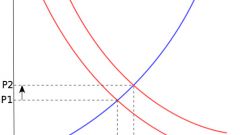Instruction
1
The elasticity of demand makes sense to find each time you change one of the following factors: price of product, income level of consumers. Based on the obtained value the economist can determine, positively or negatively it will affect the enterprise of profit. In accordance with this manual if necessary, adopt a decision on the introduction of corrective measures.
2
To determine the elasticity of demand, you need to have accurate information on prices and volumes of products for the beginning and end of the reporting period:
Kets = (∆q/q)/(δp/p), where KEC – the coefficient of elasticity at the price, q – quantity, p – price per unit of goods.
Kets = (∆q/q)/(δp/p), where KEC – the coefficient of elasticity at the price, q – quantity, p – price per unit of goods.
3
The same principle is calculated the coefficient of elasticity by income:
CED = (∆q/q)/(∆i/i), where I is average consumer income (from the English. income).
CED = (∆q/q)/(∆i/i), where I is average consumer income (from the English. income).
4
On the elasticity of demand is largely influenced by the prevalence and easy availability of materials for the manufacture of certain products. Inelastic goods are necessities (food, medicine, clothes, electricity). Also, these include minor budget items, such as pens, pencils, toothbrushes, matches, etc., as well as products that are difficult to replace bread, gasoline, etc.
5
The highest elasticity of demand have goods, which production requires rare, and therefore very expensive materials. Such products include jewelry products, the coefficient of elasticity which is much greater than unity.
6
Example: to determine the elasticity of demand for potatoes, if you know that the average income of consumers per year has increased from 22000 to 26000 rubles, and sales of this product increased from 110000 to 125000 kg.
Solution.
In this example, we calculate the coefficient of elasticity of demand under the income. Use the ready-made formula:
CAD = ((125000 - 110000)/125000)/((26000 - 22000)/26000) = 0,78.
Conclusion: the value of 0.78 is in the range from 0 to 1, therefore, is a product of the first necessity, the demand is inelastic.
Solution.
In this example, we calculate the coefficient of elasticity of demand under the income. Use the ready-made formula:
CAD = ((125000 - 110000)/125000)/((26000 - 22000)/26000) = 0,78.
Conclusion: the value of 0.78 is in the range from 0 to 1, therefore, is a product of the first necessity, the demand is inelastic.
7
Another example: find the elasticity of demand for fur coats with the same rate of personal income. Sales of coats increased in comparison with last year from 1000 to 1200 products.
Solution.
CAD = ((1200 - 1000)/1200)/((26000 - 22000)/26000) = 1,08.
Conclusion: QED > 1, this is a luxury item, demand is elastic.
Solution.
CAD = ((1200 - 1000)/1200)/((26000 - 22000)/26000) = 1,08.
Conclusion: QED > 1, this is a luxury item, demand is elastic.



